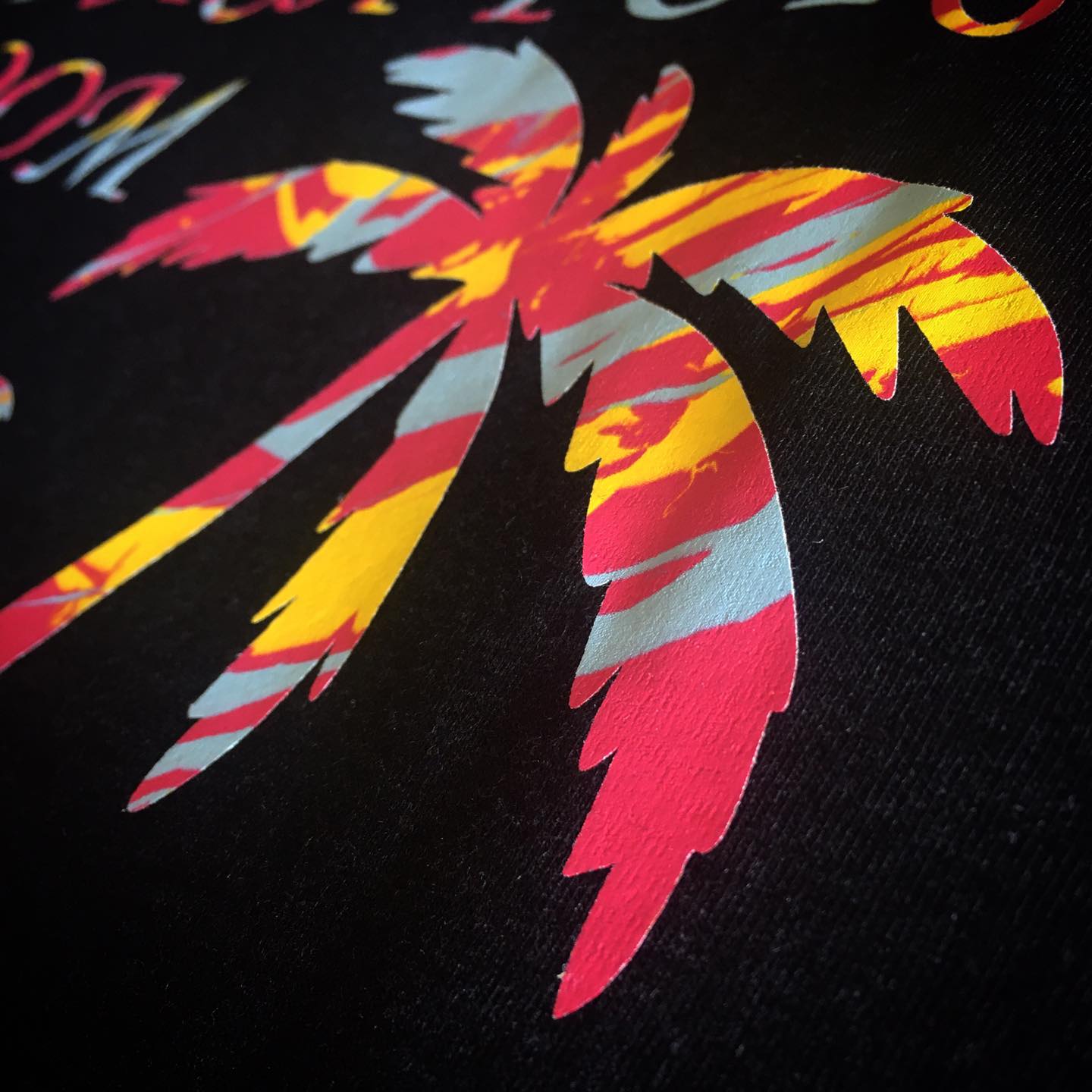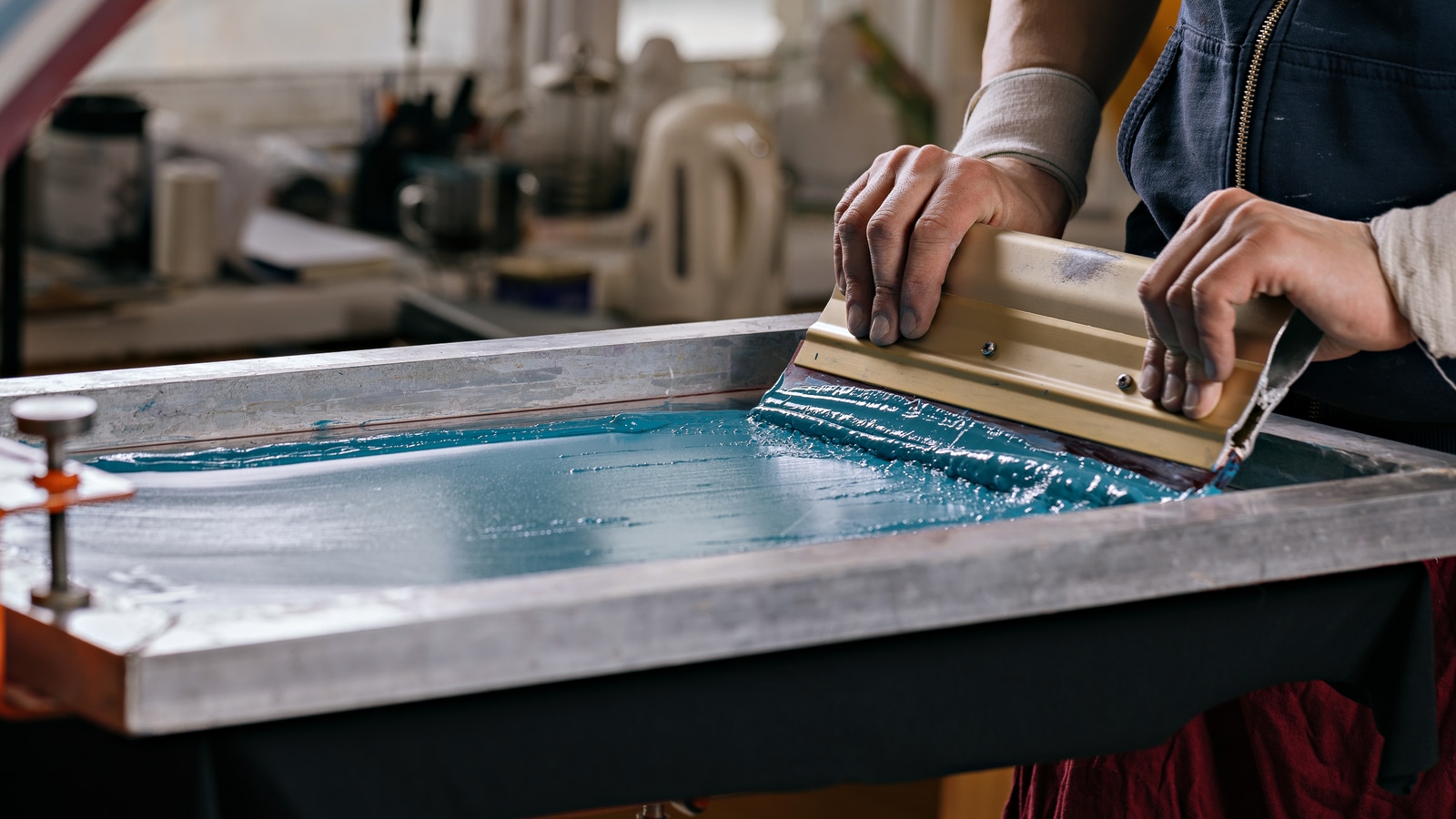Creative T-Shirt Printing Ideas for Small Brands
Display Printing Uncovered: Whatever You Need to Learn About Tee and Garment Printing Methods
Screen printing is a fascinating approach that incorporates art with method, using endless possibilities for imagination. Ready to explore the vital aspects that make screen printing an art type?
The Basics of Display Printing: Exactly How It Functions
When you dive into display printing, you'll discover it's both a science and an art. At its core, screen printing includes producing a pattern, or screen, that allows ink to pass with only in details areas.
Next, you'll blend your inks and prepare your printing surface area. Position the screen over the material, then utilize a squeegee to push ink through the display onto the garment. This process calls for precision, as you desire clear, lively prints. After printing, you'll cure the ink with warmth, ensuring it sticks to the fabric and lasts with washes. Each action is important, and grasping them will certainly raise your screen printing abilities, changing easy garments right into unique, expressive items.
Sorts Of Screen Printing Techniques
When you realize the basics of screen printing, it's time to check out the numerous techniques that can raise your styles. One popular approach is typical display printing, where ink is pressed through a stenciled screen. This technique is wonderful for strong, lively shades. After that there's water-based ink printing, which offers a softer feeling and is environmentally friendly, but it requires a different technique to healing.
If you're going for great information, think about discharge printing. This strategy gets rid of color from the material, leaving a soft, vintage look. An additional option is plastisol printing, known for its toughness and dazzling shades, making it a favored for numerous brand names. Finally, explore halftone printing to develop slope results and complex designs. Each strategy has its one-of-a-kind appeal, so do not wait to attempt them bent on locate what suits your design best!
Important Equipment for Display Printing
To attain stunning outcomes in screen printing, having the ideal devices is fundamental. You'll require a durable display printing framework, which holds the mesh that transfers your layout onto the garment. Next off, invest in high-grade squeegees; these are essential for applying ink uniformly throughout the screen.
Choosing the Right Inks and Products
When selecting inks and materials for screen printing, you need to take into consideration the kind of ink that functions ideal for your job. Consider material compatibility to guarantee your designs look excellent and last lengthy. Additionally, check out eco-friendly ink alternatives to make your printing procedure more sustainable.
Types of Display Inks
Selecting the best screen ink is essential for attaining vivid, sturdy prints that fulfill your job's requirements. There are a number of sorts of display inks to check out. Plastisol ink is popular for its convenience and ease of usage, giving exceptional color opacity on dark fabrics. Water-based ink, on the various other hand, provides a softer feeling and is environment-friendly, making it optimal for those wanting to reduce their ecological effect. Discharge inks eliminate dye from the textile, leading to a soft, vintage appearance however require details handling. Finally, specialized inks, such as glow-in-the-dark or metallic, can add distinct effects to your styles. Assess your task requirements and choose the ink that straightens best with your preferred end result.

Fabric Compatibility Considerations
Recognizing textile compatibility is vital for achieving premium display prints, especially because various products react uniquely to numerous inks. When picking inks, think about the fabric kind-- cotton, polyester, or blends. For cotton, water-based inks function well, using softness and breathability. Polyester, on the other hand, typically calls for plastisol inks for far better bond and vivid colors. If you're printing on blends, you might require to utilize a mix of both kinds. Always evaluate your inks on example material to guarantee they stick appropriately and maintain shade stability. Additionally, remember that textile weight and structure can affect the final outcome, so selecting the best ink and product combination is important for your task's success.
Eco-Friendly Ink Options
Environmentally friendly inks are coming to be a prominent option for display printers that want to lessen their ecological influence while keeping quality. When selecting inks, think about water-based inks, which are much less unsafe and simpler to clean up compared to traditional solvents.
In addition, seek inks made from eco-friendly sources, such as soy or vegetable-based alternatives. By picking the appropriate inks and products, you'll not just produce magnificent designs but likewise add to a much more lasting printing procedure. Make the button, and your prints will show your commitment to the setting!
Preparing Your Style for Display Printing

Submit Layout Demands
To assure your layout looks lively and sharp on textile, you'll require to pay close focus to file layout demands for screen printing. Make sure your design has a clear background to avoid unwanted white sides on your prints. Maintain shade modes in mind; CMYK is standard for display printing, so transform your RGB creates accordingly.
Color Splitting Up Strategies
Color separation is an important action in preparing your style for display printing, and grasping it can significantly improve your print top quality. You'll require to break your layout into private colors, as each shade needs a separate display throughout printing. Start by recognizing all the colors in your style and produce layers each. You can make use of software like Adobe Photoshop or Illustrator to separate and separate colors effectively. Be particular to conserve each layer as a separate file, generally in a layout like TIFF or PSD. This precision not only guarantees exact color representation yet also improves the click over here printing procedure. By focusing on shade separation, you'll attain vivid and professional lead to your screen-printed garments.
Resolution and Size
Achieving the very best lead to display printing begins with assuring your style has the right resolution and dimension. Preferably, your art work ought to be at the very least 300 DPI (dots per inch) for sharp, clear prints. If you use reduced resolution, your final item may look unprofessional and pixelated.
When it involves dimension, consider the measurements of your print area. Style your art work to match the final print size, ideally developing it in the actual dimensions you'll be publishing. This means, you'll avoid any type of unanticipated scaling issues.
Always examine your style in both vector and raster layouts. Vector graphics can be scaled without shedding quality, making them optimal for screen printing. Preparing correctly will guarantee your design looks impressive on every garment!
Step-by-Step Display Printing Process
Screen printing is a vibrant procedure that allows you to produce vivid designs on different surfaces. To get begun, you'll need a display, emulsion, and your picked ink. Prepare your display by cleaning it extensively. Next off, apply the emulsion equally and let it dry in a dark area. When completely dry, expose your screen to light with your style positioned on it, which will certainly harden the solution where the light hits, developing a pattern - screen printing kit.
Pour ink onto the display and utilize a squeegee to push the ink via the pattern onto the fabric. Lift the display carefully and allow the print completely dry. You've effectively screen printed your layout.
Tips for Effective Screen Printing Projects
While you're diving into you can find out more your screen printing projects, keep in mind that prep work is vital to success. Beginning by gathering all your products-- inks, mops, garments, and displays. A clean office assists stop unwanted errors, so clean before you start.
Following, validate your artwork is high-resolution and effectively sized for your garment. Evaluate your screen for appropriate exposure and tidy it thoroughly to avoid spots. When blending your inks, comply with the supplier's standards to accomplish the right uniformity.
During printing, use also pressure with your squeegee for constant outcomes. Don't hurry; take your time to verify each print satisfies your standards. After printing, let your garments completely dry totally prior to dealing with or packaging them.
Last but not least, constantly maintain a sample of your benefit future referral. In this manner, you can assess your progress and improve your techniques in time. Satisfied printing!

Often Asked Concerns
How much time Does It Take to Establish a Display Printing Work?
Establishing a screen printing task commonly takes around half an hour to an hour. You'll prepare the screens, mix inks, and change the press. The moment differs based upon complexity and experience, so stay organized!
Can I Publish on Various Material Types Utilizing the Same Strategy?
Yes, you can print on different material kinds utilizing the exact same technique, yet you'll require to adjust your setups and inks. Some textiles absorb ink in different ways, so exploring warranties the very best results for each material.
What Are Typical Blunders to Prevent in Screen Printing?
When screen printing, prevent typical errors like making use of the incorrect ink, overlooking proper direct exposure times, or avoiding pre-press checks. Always examine your configuration and keep tidy displays to ensure quality outcomes each time.
How Can I Correctly Tidy and Keep My Screen Printing Tools?
To properly tidy and maintain your screen printing devices, you must routinely wash screens with ideal solvents, examine mops for wear, and assure all devices are saved dry and dust-free. Uniformity avoids costly repair services and improves efficiency.
Is Display Printing Eco-friendly Compared to Various Other Techniques?
Screen printing can be more eco-friendly than various other approaches, specifically if you use water-based inks and look what i found eco-conscious materials. By choosing sustainable materials and methods, you decrease waste and reduce your effect on the world.
Screen Printing Uncovered: Whatever You Required to Know Concerning Tee and Garment Printing Strategies
At its core, screen printing entails creating a stencil, or display, that permits ink to pass with only in certain locations. Position the screen over the textile, then utilize a squeegee to push ink via the screen onto the garment. One popular approach is standard screen printing, where ink is pushed via a stenciled display.When choosing inks and products for screen printing, you need to take right into account the kind of ink that functions best for your project.